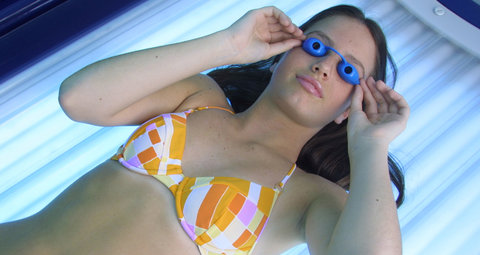|
How Tanning Changes the Brain
Posted on: 03/18/12
The brains of frequent tanners may be similar to those of addicts.
Scientists have suspected for some time that frequent exposure to ultraviolet radiation has the potential to become addictive, but the new research is the first to actually peer inside the brains of people as they lay in tanning beds. What the researchers found was that several parts of the brain that play a role in addiction were activated when the subjects were exposed to UV rays. The findings, which appear in the coming issue of the journal Addiction Biology, may help explain why some people continue to tan often despite awareness about risks such as skin cancer, premature aging and wrinkles. “What this shows is that the brain is in fact responding to UV light, and it responds in areas that are associated with reward,” said Dr. Bryon Adinoff, a professor of psychiatry at the University of Texas Southwestern Medical Center and an author of the study. “These are areas, particularly the striatum, that we see activated when someone is administered a drug or a high-value food like sugar.” Despite all the public warnings about skin cancer, tanning remains as popular as ever, with nearly 30 million Americans tanning indoors every year, and more than a million visiting tanning salons on an average day. Frequent users say they simply enjoy the way they look with darker skin. But in recent years, scientists also began to wonder whether deliberately ignoring the potentially lethal side effects of regular UV exposure was a sign that the motivation for frequent tanners was more than skin-deep. Could habitual tanning be an addictive behavior? A study in 2005 did show that a large proportion of sunbathers met the psychiatric definition of a substance abuse disorder, based on their answers to a variation of a test often used to help diagnose alcohol addiction. But Dr. Adinoff and his colleagues decided to go a step further. They recruited a small group of people from tanning salons who said that they liked to tan at least three times a week and that maintaining a tan was important to them. The frequent tanners agreed to be injected with a radioisotope that allowed researchers to monitor how tanning affected their brain activity. On one occasion, the study subjects experienced a normal tanning session. But on another occasion, the researchers used a special filter that blocked only the UV light, although the tanners weren’t told of the change. Brain images later showed that during regular tanning sessions, when the study subjects were exposed to UV rays, several key areas of the brain lighted up. Among those areas were the dorsal striatum, the left anterior insula and part of the orbitofrontal cortex – all areas that have been implicated in addiction. But when the UV light was filtered out, those areas of the brain showed far less activity. The researchers also found evidence that the tanners appeared to know — on a subconscious level, at least — when they had undergone sham tanning sessions and not received their usual dose of UV rays. The tanners, questioned after each session, expressed less desire to tan after the real sessions, indicating they had gotten their fill. But on days when the tanners were unknowingly deprived of the UV rays, their desire to tan after the session remained as high as it was before the session began. “They all liked the session where they got the real UV light,” said Dr. Adinoff. “There was some way people were able to tell when they were getting the real UV light and when they were not.” Dr. Adinoff said the research suggests that some people appear addicted to tanning, a finding bolstered by the fact that many longtime tanners have a difficult time stopping or even just cutting back on tanning sessions. He said the research was inspired by a colleague, based on her experiences with dermatology patients. “She approached me because of her concern about young adults who were coming to see her with these beautiful bronze tans,” he said. “And she would cut out skin cancers, and they would immediately go back to tanning.” COMMENTS
Be the first to post a comment! Post A Comment:

|
.gif)




.jpg)

